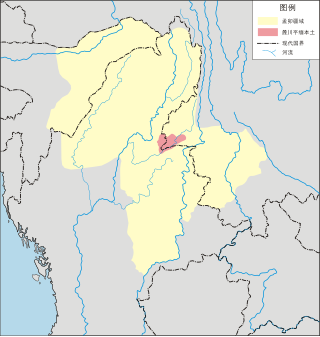Si Kefa
Ruler of Möng Mao From Wikipedia, the free encyclopedia
Si Kefa (Chinese: 思可法; pinyin: Sī Kěfǎ), also known as Hsö Hkan Hpa (Tai Nüa: ᥔᥫᥴ ᥑᥣᥢᥱ ᥜᥣᥳ; Shan: သိူဝ်ၶၢၼ်ႇၾႃႉ) or Tho Chi Bwa (Burmese: သိုချည်ဘွား), was a Tai ruler who founded the kingdom of Möng Mao in and around the frontier of modern-day China, Myanmar, and India. He sacked the Burmese kingdoms of Sagaing and Pinya in 1364.[1][2]

| Hsö Hkan Hpa Si Kefa, Tho Chi Bwa | |
|---|---|
| Ruler of Möng Mao | |
| Reign | 1335–1369 |
| Successor | Hsö Pem Hpa |
| Born | 1294 |
| Died | 1369 (aged 74–75) |
Name
According to the Burmese chronicles, his name was Tho Chi Bwa, younger brother of Tho Han Bwa, lord of Maw (Mong Mao), and son of Tho Khin Bwa, lord of Maw.[note 1] Different transliterations of his name in the local Tai language include Sa Khaan Pha, Soe Khan Fa, Chau-ki-pha, Tai-Pong, and Hso-Kip-Hpa.[3]
Rise to power
The exact date of Si Kefa's accession to the throne is unknown in Chinese records. In 1330, a ruler of Luchuan (Möng Mao) sent tribute to the court of the Yuan dynasty, but it's unclear if this ruler was Si Kefa. At the time, Luchuan was just one of many minor Tai polities in southwestern Yunnan. Luchuan was not mentioned again until 1342, by which point Si Kefa had already transformed his kingdom into the region's dominant power, and the Yuan were sending a punitive expedition against him.[4]
Tai chronicles are also unclear about the exact date of his accession, sometimes differing considerably from one chronicle to another. The most plausible date is 1335, the year of his accession as the "supreme ruler of mist-cloaked Möng Mao" in the Heimeng Gumeng.[5][6]
Reign
Summarize
Perspective
Si Kefa first established his capital at Wing Sè Hai, but two years later he built a new capital at Sè Lan (between Namhkam and Muse), fortifying it with strong walls and deep moats.
Once he had established his power in Sè Lan, he sent messengers to the rulers of the Hsenwi states - Hkun Tai Paw and his three sons named Tao Noi Chè, Tao Noi Myen, and Saü Pan Noi - demanding their submission. They flatly refused, so Si Kefa raised an army and invaded Möng Yin, driving out Hkun Tai Paw and his sons. With the war lost, they came to terms with Si Kefa, agreeing to become his subjects and giving him the princess Nang Ai Hkam Hpawng in marriage.
One year later, Si Kefa sent messengers to the rulers of Möng Mit, demanding the submission of the brothers Sao Tai Hkön, Sao Tai Hkai, Sao Tai Tao, Sao Tai Ting, and Sao Hkam Awn. They killed seven of his messengers and sent back the remaining three to bid him defiance. Si Kefa then invaded Möng Mit with a large army and defeated them. The senior prince, Sao Tai Hkön, refused to surrender and was executed. The other princes submitted and Sao Tai Hkai was appointed as the new saopha of Möng Mit.[7]
Si Kefa engaged in repeated raiding on neighboring chieftainships and in 1348–49 the Yuan court sent an expedition under Marshall Dashibadu to put an end to it. The expedition failed to subdue him, but Si did send his son Mansan to the Yuan court to offer allegiance. The Baiyi Zhuan reports that while Mansan "accepted the Court's calendar and offered tribute, his clothing, paraphernalia and system remained like those of a king."[8] Both the Mong Mao and Hsenwi chronicles provide lists of the far-flung domains he is said to have controlled reaching to the border of the Kingdom of Dali in the north, Xishuangbanna to the south, Central Myanmar to the southwest, and Yongchang to the west.[9]
In the Burmese chronicles, he is remembered as the leader of the Maw forces that sacked the kingdoms of Sagaing and Pinya in 1364. He brought back King Narathu of Pinya and the loot to the Maw country. In the wake of the attacks, a Sagaing prince named Thado Minbya founded the Ava Kingdom in 1365.[10][2]
Si Kefa has a privileged position in Mong Mao chronicle history as defining "an age when the Tay [Tai] lived in an expansive independent kingdom ruled by their own kings and use it as a point of departure for their accounts of post-fifteenth century history"[9]
Notes
- (Maha Yazawin Vol. 1 2006: 272) and (Hmannan Vol. 1 2003: 392): Tho Chi Bwa was a brother of Lord Tho Han Bwa. (Yazawin Thit Vol. 1 2012: 170): Tho Chi Bwa was a son of Tho Khin Bwa, Lord of Maw.
References
Bibliography
Wikiwand - on
Seamless Wikipedia browsing. On steroids.
